What is Bhoota Kola? Who is a Bhoota or Daiva? The author, who has witnessed rituals in her ancestral home to appease the Bhootas, talks to experts and mediums or Daiva Patris.
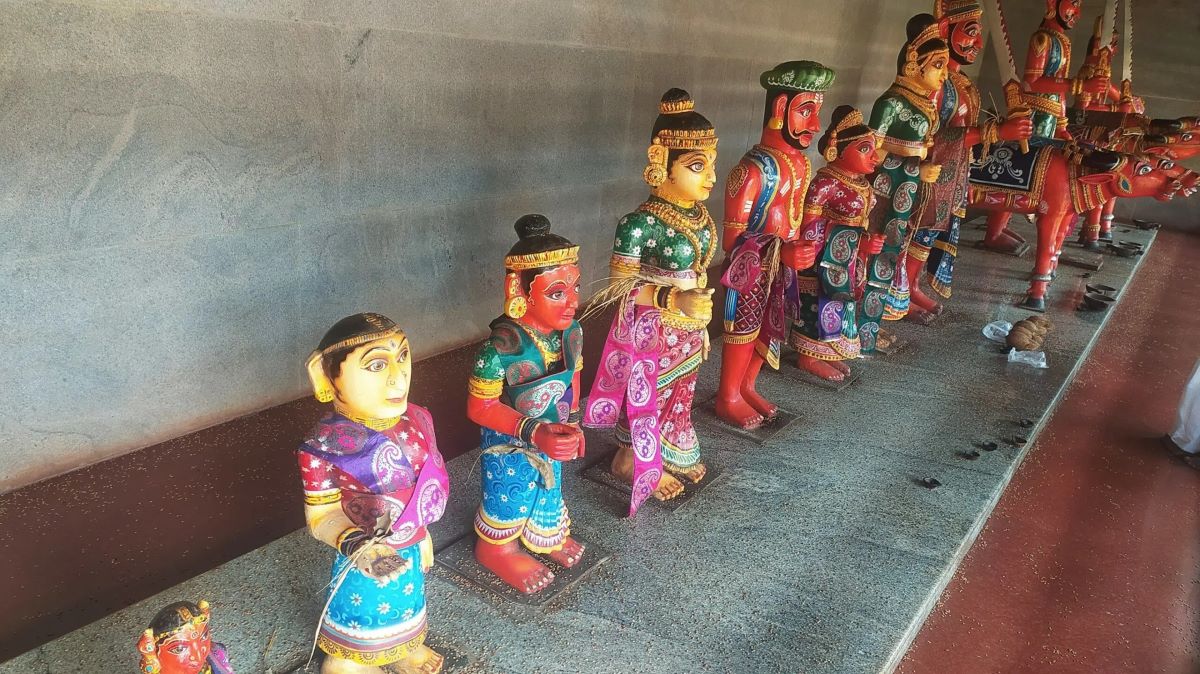
Bhoota Kola or Daiva Aradhana is the practice of worshipping spirits prevalent in Tulu Nadu (Deeksha Devadiga/South First)
Every summer vacation between the month of April-May, I get to witness an annual ritual to appease Nandikeshwara, a Daiva or Bhoota, in our ancestral home in Kundapura in Karnataka’s Udupi district. This ritual is known as Jakani or Tambila.
On this occasion, a fire is lit at the Bhoota Sthana after thoroughly cleaning the area. An offering is prepared made of powdered brown rice that is fried, jaggery, and coconut shavings.
The mixture is offered on banana leaves. A small cot is placed near the shrine and another banana leaf is spread on it. Then a ball of cooked rice, rendered yellow by the addition of turmeric, is placed on the leaf. A cloth wet with kerosene is coiled around a stick and placed in between the cooked rice ball and lit up.
Above the flame, a chicken is held and its neck is cut off so that the drops of blood fall on the rice. After lighting some incense sticks, the ritual comes to an end. The family then cooks the bird and consumes it as prasad.
Tuluva people have lived in the coastal stretch of Karavali, a historically significant stretch of land situated by the southwestern coast of India. The land is known for its rice cultivation, coconut trees, and rich wildlife.
People belonging to the Bunt, Mogavira, and Billava communities reside in the area and for ages have been ritualistically practising the Yakshagana dance form, the serpent-worship known as Nagaradhane, and Bhoota-Kolam or Bhoota Kola or Daiva Aradhana — recently seen in the Kannada movie Kantara.
Some Bhootas are also referred to as Daivas, a term meaning divine beings.
The abundance of forest life has afforded a safe home to many wild animals, including tigers, wild boars, deer, elephants, and snakes. Cobras and pythons are very common and easily spotted in one’s farms and backyards.
To kill a cobra even by accident is regarded as a sinful act that necessitates atonement. If one comes across a dead cobra, they have to follow certain rituals and dispose of the body. If for any reason they fail to do so, it is believed a curse would befall them.
It is very common to find a Naga Bana with serpent stones or an Ashwatha Katte (pipal tree with a platform) in villages.
Almost every house has a separate room or corner dedicated to the Bhoota, known as Bhoota Sthana.
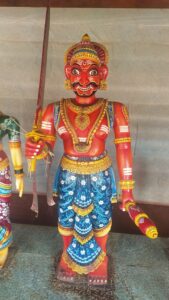
Bhoota idol at Shree Veerabhadraswamy Temple in Hiriadka, Kundapura, Udupi district (Deeksha Devadiga/ South First)
These sthanas have metal and wooden masks of Daivas or spirits, which are worshipped. It is this mask that is worn by special dancers or priests who act as a medium or a vessel for the Bhootas.
Bhoota worship plays a significant role in both the social and economic lives of the local people. No big decisions or sometimes even small ones are made without consulting them.
Growing up in the community, it was common for me to pray to the Bhoota before any Vedic Gods.
The first offering for any function — be it marriage or funeral — is made to them. They are invoked to ensure a good crop season and for the protection of cattle and farms.
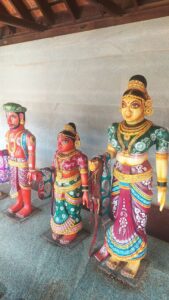
Bhoota idol at Shree Veerabhadraswamy Temple in Hiriadka, Kundapura, Udupi district (Deeksha Devadiga/ South First)
Bhoota worship is not confined to a particular Daiva or particular area or caste or family in any given community. The locals regard them as sacred beings and have complete faith in their capabilities in shaping their welfare and health.
For a long time, locals have been observing festivals and rituals honouring their local or family Bhootas. Along with an overwhelming sense of devotion, many also are motivated by fear.
A study was published on the ‘Bhuta Cult’ in South Karnataka (then South Kanara) during the 1971 Indian Census. It calls Bhoota Kola “a cult practised in the Karavali districts as a religion and has its own set of beliefs and rituals”.
“When displeased or angered, the Bhutas are believed to cause misery and create obstacles for devotees until they admit to the powers of the Bhutas,” it notes.
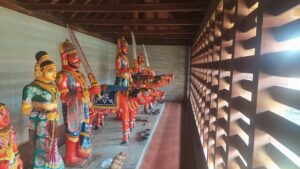
Bhoota idol at Shree Veerabhadraswamy Temple in Hiriadka, Kundapura, Udupi district (Deeksha Devadiga/ South First)
The priest or the performer holds bells or swords and dances or sways to the music created with the traditional clarinets.
They attain a trance-like state and act as vessels for the Bhoota to enter. After the Bhoota is summoned, they are offered sacrifices, including rice, meat, and alcohol, which varies with every village or town.
According to writer and culture expert Dr Purushottama Bilimale Bilimale, there are around 600 local Bhootas in the Karavali stretch. He told South First that there are arguments the number may cross a thousand. But he noted that some Bhootas have multiple names, which has contributed to such a claim. For example, Karakala’s ‘Kalkuda Kallurti’ Bhoota is also known as ‘Pashana’ Bhoota.
Each of these Bhootas has a story or narrative — known as Paddanas, which are epic folk songs. These songs are sung by a narrator or orator at the time of Bhoota worship when the impersonator gets into a trance.
These Paddanas describe the hardship or turmoil of an individual Bhoota in their human or animal form. It explains their journey of attaining enlightenment and the status of Bhoota. Many also explain the reason behind the existence of a Bhoota at a particular shrine or region.
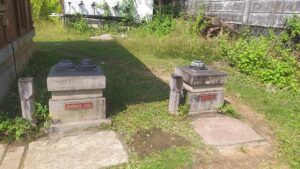
Bhoota idol at Shree Veerabhadraswamy Temple in Hiriadka, Kundapura, Udupi district (Deeksha Devadiga/ South First)
These epic songs and the 600 names of the Bhootas were first recorded in 1871–72 by AC Burnell and this was published in Indian Antiquary, Volume XXIII, 1894, along with the transliteration and translation of several Tulu Paddanas in a series of articles, said Bilimale.
The Devil Worship Of The Tuluvas written by AC Burnell is perhaps the first English work on Tulu Paddanas. He calls it the ‘Devil Worship of Tuluvanad’, which is his translation of Bhoota Kola of Tulu Nadu.
Praveen Ammembala, a Tulu expert speaking to South First, called it a classic case of a language barrier during translation. “Bhoota Kola is a sacred art form, it has nothing to do with devil worship. Bhoota means the spirit here and it helps you understand the sincerity and the greatness of Tulu Nadu,” he noted.
The heroes or the main characters in these epic songs are mostly born to a family belonging to the Koraga community — one of the most backward Scheduled Tribes of the district. There are few examples of Bhootas belonging to upper-class families or born into noble houses.
Dr Bilimale, a recipient of many honours including the Karnataka Folklore Academy award, highlighted the difference between the Gods and Bhootas and said, “One thing that distinguishes them from the Vedic Gods is these heroes are not a reincarnation of any Gods. The Vedic and Hindu Gods when born are incarnations of another existing God, which is why they are recognised when in their mothers’ wombs. Their birth is celebrated by other deities and mangala vaadya (music) is heard in the sky. They are achievers by birth because they are born to fulfil a certain prophecy.”
Bhootas are individuals who grew up in a society that was tough for them because of their birth in a backward community. Certain conflicts resulted in their early death or disappearance, which is not the case for Vedic Gods who attain moksha only after fulfilling their birth prophecy.
The Bhootas are not born to fulfil any prophecy or achieve something, said Bilimale. He added that the individuals are revered as Bhootas only after their death.
Bhootas exist in different forms and shapes.
Some exist in the form of a boar (Panjurli), some in the form of a tiger (Pilichamunda), and some in the form of a bull (Nandigona). Some are differentiated by sex.
The way of illustration of the human form shows that Annappa, Ali Bhoota, Kalkuda, Bobbarya Kod-dabbu, Kora, Koti-Channayya (together called Baiderukalu) etc., are male while Kallurti, Deyi Baidyati, Tannimaniga, Ummalti, Ullalti, Korati and almost all names ending with Taye (Kannada word meaning mother) are female. Some are androgynous (Ardhanareeswara) with a male head and a female body, known as the Jumadi Bhoota.
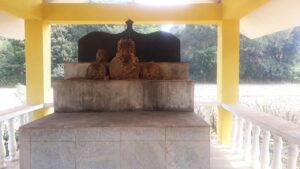
Bhoota shrines are found outside many local homes in the coastal stretch of Karavali (Deeksha Devadiga/ South First)
Each Bhoota is believed to govern a particular aspect of human welfare and appeasing that spirit might result in favourable results on that front.
Pilichandi (a Bhoota in tiger form) is worshipped to protect cattle from being lifted away by tigers and for preventing crop thefts.
Korage is believed to protect cattle from deadly diseases. Fishermen give prayers and offerings to Bobbarya before leaving on an expedition, while Mariamma is believed to control epidemic diseases.
Panjurli, seen in the movie Kantara, is believed to protect farms from wild boars and hence is prayed to by people involved in agriculture. Panjurli is also known as Guliga, the term for burrowing into the ground.
The term Daiva or Daivangalu is usually applied to those Bhootas who do not partake of animal food by way of sacrifice. Kodamantaye is an example of one such Daiva. In fact, this author has mostly heard the term Daiva being used, not Bhoota.
The Daivas are honoured at several places with royal ornaments, gold-plated swords, gold-plated masks, and golden prabhavalis (halo).
The objects used for daily prayers of the Bhoota are the ghante or the bell, and the goblet which contains the holy and oil lamp amongst other pooja items.
Other important objects are swords, ceremonial dresses, ornaments, and the wooden or metallic mask that differs from Bhoota to Bhoota. These objects are taken out during annual or festive celebrations and are considered sacred because of the nature of their use.
Some rituals may differ with different regions but the most common feature is the invoking of the Bhoota by a priest, and the offerings of food and drinks — which includes animal sacrifice in some places. There is an absence of differences based on caste, religion, and sex.
The village or a family comes together to seek guidance over a family affair or dispute and respects the decision made by the Bhoota.
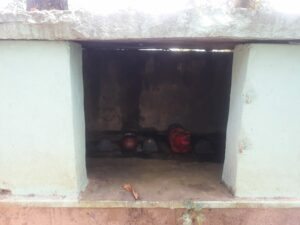
Each Bhoota is believed to govern a particular aspect of human welfare and are prayed to accordingly (Deeksha Devadiaga/South First)
The selection of the person to act as a medium for the Bhoota also differs in different places. Sometimes, people might not even realise that they are a medium.
Theejaappa, a Bhoota Kola artist from Bantwal — a taluk in Dakshina Kannada — has been a medium for the Bhootas since he was 16. The practice of Bhoota Kola has been in his family for the last four generations.
He doesn’t consume fish though he belongs to a community where it is partaken. But he notes that it is a personal choice.
Theejaappa told South First, “We learnt all the Paddanas, also known as Sandhi, from our grandparents. We teach our kids and one day, they will teach theirs. No film or movies can influence the age-old stories.”
He also said, “At least in our village, you have to be married and after the Bhoota’s approval are we chosen as a medium. It can take some time to happen. My older son got his blessings but my younger one is still waiting for his blessing from the Daiva”.
Small rituals are carried out if someone falls sick or has an accident or even if they have dreamt something unusual.
The Daiva Patri (medium) would take a bath near the well in cold water and then enter the house. They would wear ceremonial clothes, which consist of tightly fitted trousers and then wear a vermillion-coloured saree as a dhoti. They would also wear a pair of gejje (ghungroo) to their ankles.
Then holding a bunch of areca flowers, they would stand in the pooja station or circle created for them. The piper or a member of the family starts to play a musical instrument on a high note. A small aarti is offered to the priest. Some go to the extent of lighting the camphor on their palms themselves and worship the Bhoota idols.
The atmosphere changes with the loud sound of the instrumental music and the aarti. In a few minutes, the Daiva Patri’s legs start to shake and they rub the areca flowers on their face in a circular motion.
During annual celebrations, they are held by a few people for balance and to help them with torches lit with fire. They run the flames to their bare chest and sometimes even walk on fire.
After getting fully possessed, the Daiva Patris situate themselves in a chair or a standing position close to their idol. At this point, family members and other people can start seeking advice.
There is always an intermediary person between the Bhootas and the people. This is because sometimes the Bhootas talk in different languages or variations of the language, which might be difficult for one to understand.
There is a reason behind holding the areca flowers in their hand. After listening to one’s problem, the Daiva Patri would involuntarily break a few pieces of the petals and deposit them into a plate nearby or devotees’ hands.
If the number of pieces of petals is odd, then it’s a good sign. But if they are even, then the Daiva would suggest some alternative measures.
After hearing everyone and providing solutions, the Bhoota would leave the body of the priest or Daiva Patri when sprinkled with thirtha (holy water). They go back to their normal senses and can be seen normally conversing with the locals.

Apr 26, 2024

Apr 26, 2024

Apr 26, 2024

Apr 26, 2024

Apr 26, 2024

Apr 26, 2024